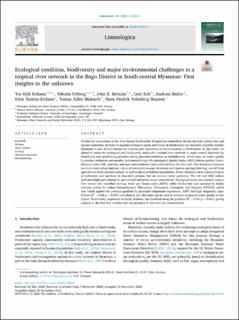| dc.description.abstract | Freshwater ecosystems in the Indo-Burma biodiversity hotspot face immediate threats through habitat loss and species extinction. Systems to monitor ecological status and trends in biodiversity are therefore crucially needed. Myanmar is part of Indo-Burma but with no past experience of biomonitoring in freshwaters. In this study, we aimed to assess the ecological and biodiversity status of a lowland river network in south-central Myanmar by identifying and quantifying pressures using macroinvertebrates as bioindicators. Novel data on water quality (nutrients, sediments and metals), hydromorphology (Morphological Quality Index; MQI), habitat quality (Litter-Siltation Index; LSI), land use, and macroinvertebrates were collected from 25 river sites. The dominant pressures on rivers were urban land use, inputs of untreated sewage, in-stream and riparian garbage littering, run-off from agricultural fields and plantations, as well as physical habitat degradation. Water chemistry data indicated inputs of sediments and nutrients to degraded streams, but no obvious metal pollution. The LSI and MQI indices indicated high perturbation in agricultural and urban areas, respectively. Ecological status was assessed using a first version of a modified Average Score per Taxon index (ASPT), while biodiversity was assessed by family richness within the orders Ephemeroptera, Plecoptera, Trichoptera, Coleoptera and Odonata (EPTCO), which was tested against the pressure gradient by principal component regressions. ASPT had high diagnostic capabilities (R2 = 0.68, p < 0.001) and showed that the index can be used to evaluate ecological water quality in this region. Biodiversity, expressed as family richness, also declined along the gradient (R2 = 0.59, p = 0.041), giving support to the fact that current land-use practices in this area are unsustainable. | en_US |

